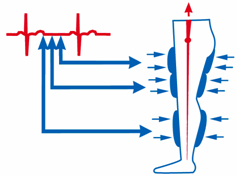How EECP® Therapy Works
EECP® therapy is typically provided in 35 one-hour treatment sessions over a period of approximately seven weeks. Additional hours may safely and effectively be prescribed to this regimen if physician evaluation of the patient’s response to treatment determines additional hours will result in greater relief of symptoms. In certain circumstances, adjusting the patient's treatment regimen to two hours per day can make it more comfortable for the patient to complete a course of EECP® Therapy.
To receive EECP® Therapy, the patient lies on a treatment table. Compressive cuffs (similar to large blood pressure cuffs) are securely wrapped around the patient's calves, thighs and buttocks. These cuffs inflate in a distal to proximal sequence in early diastole, and deflate simultaneously in late diastole just prior to the onset of systole. Inflation and deflation are specifically timed to the patient's ECG to optimize therapeutic benefit. The sequential cuff inflation creates a retrograde pressure wave that augments diastolic pressure, increasing coronary perfusion pressure and venous return to the right heart (increasing preload and cardiac output). Rapid and simultaneous cuff deflation decreases systemic vascular resistance, afterload, and cardiac workload.
 |
|
 |
|
